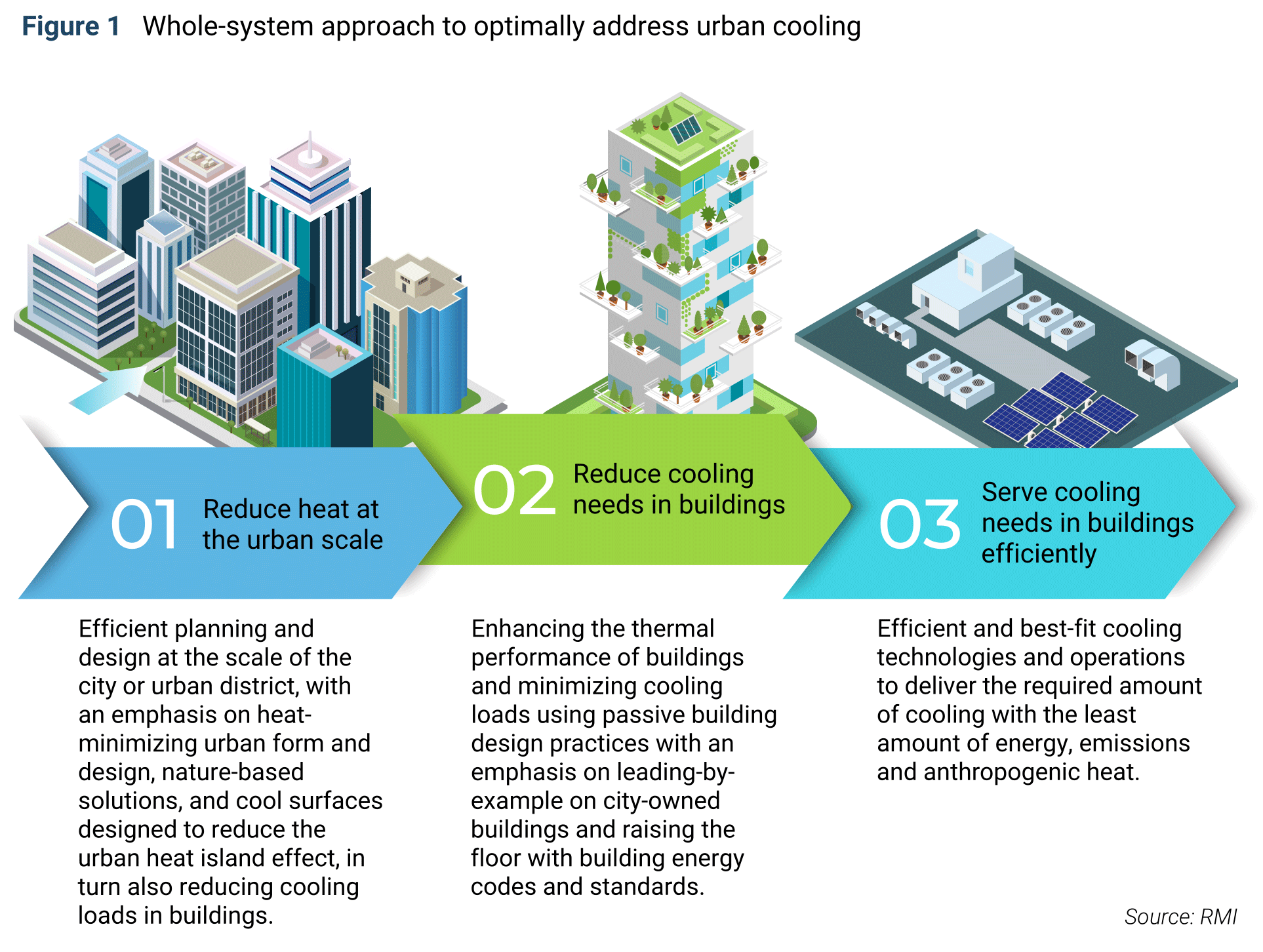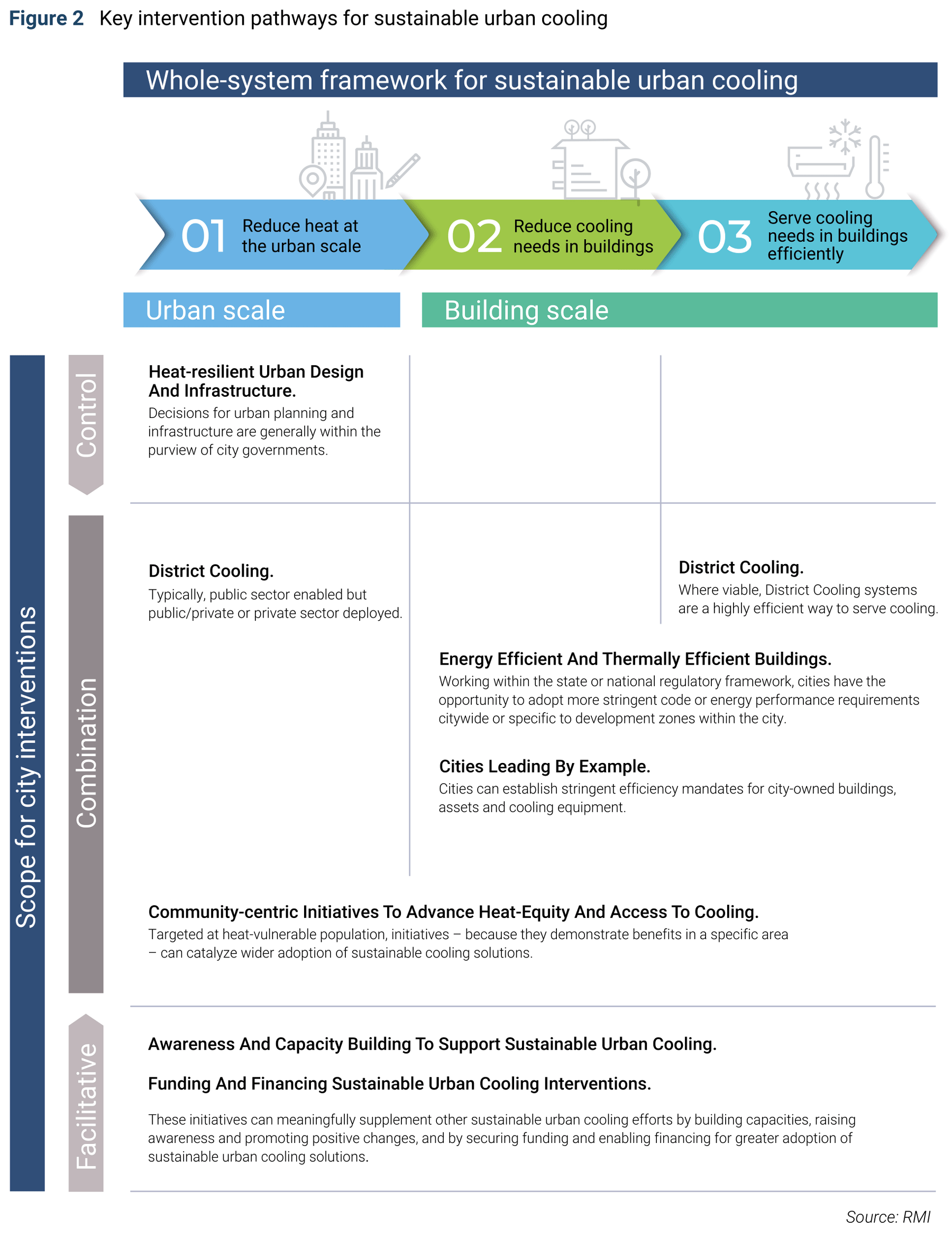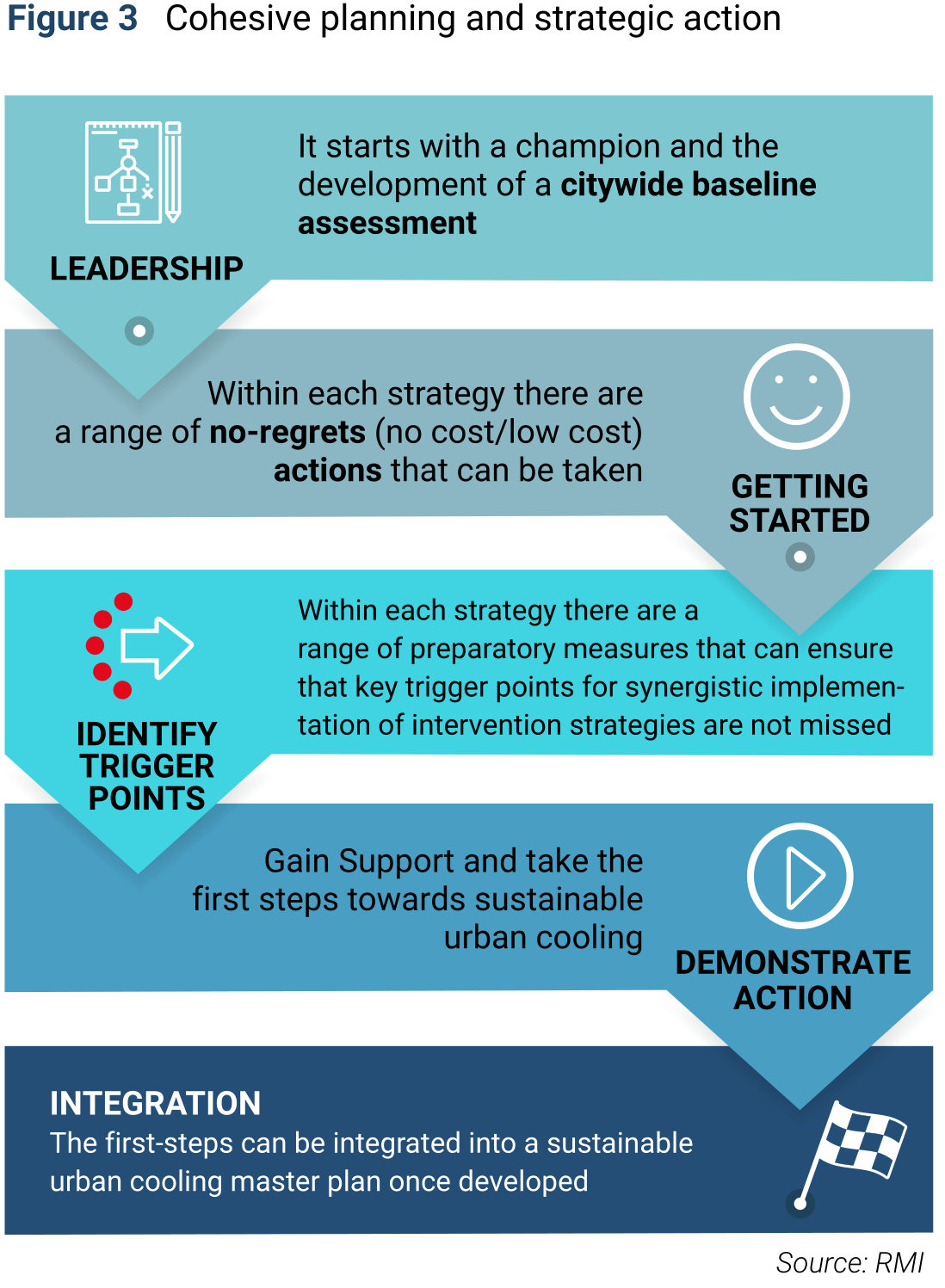
Our Cities Are Getting Too Hot
A New Handbook Offers Comprehensive, Practical Guidance on Sustainable Cooling for Cities
A 2020 novel opens with a heat wave in Northern India that kills 20 million people. The Ministry for the Future by Kim Stanley Robinson is described by reviewers as the “novel we need” and “the book of the year.” What makes the opening chapter so devastating is that it is completely, utterly plausible—not just in some distant future, but today. A new Sustainable Cooling Handbook for Cities offers solutions to ensure that doesn’t happen.
Cities Are in the Climate Change Crosshairs
By 2050, some of the most densely populated parts of the world are anticipated to routinely experience conditions that cross the human survivability threshold—a combination of heat and humidity under which a person cannot stay alive beyond a few hours.
The world’s cities are acutely vulnerable, heating up at twice the global average rate thanks to urban population growth and the urban heat island effect. By 2100, cities across the world could warm by as much as 4°C—more than twice the Paris Agreement’s goal of limiting global temperature rise to no more than 1.5°C. Approximately 1.6 billion city dwellers could be exposed to average summertime temperature highs above 35˚C (95°F).
And it is the urban poor in the Global South who will be hit hardest by rapid warming. Lower-income workers are more likely to be subjected to heat exposure, and lower-income neighborhoods are invariably hotter because they have fewer trees, less green space, and more concrete and asphalt, and are often co-located with industry. Poor people are less able to retreat into air-conditioned spaces; India’s outdoor labor force—farmers, construction workers, laborers, street vendors—comprises 400 million people, of which 165 million, 35 percent of the country’s urban population, live in slums.
The Response Exacerbates the Problem
Air conditioning, our default adaptive response to heat, has been vital to health and productivity in much of the world. Unfortunately, air conditioning is a key contributor to the warming that it seeks to counter.
About 2.3 billion people entering the middle class worldwide, mostly in the Global South, are on the verge of purchasing a room air conditioner (RAC) for the first time. Many of these will be the cheapest and least efficient units on the market, and these quick, localized fixes come with severe consequences. The emissions and rejected heat from these RACs further heat our cities, necessitating even more cooling and compounding the problem for those who are unable to afford air conditioning of their own.
Under a business-as-usual scenario, the world is going to need more than 6,200 annual terawatt-hours of electricity by 2050 just for space cooling. This approximately equals the present annual electricity consumption of the United States, Japan, and Germany combined.
Air conditioning is especially problematic because it drives peak electricity demand, typically met by the most expensive and polluting power generation. This translates into a huge potential emissions problem: 3.5 gigatons of CO2 equivalent attributable to RACs by 2050—even if we phase out the most destructive refrigerants (the other main emissions contributor from air conditioning), consistent with global agreements. Total emissions for the entire United States in 2019 were 4.8 gigatons.
We urgently need to transition to more sustainable and equitable ways to cool our cities. City officials recognize that urgency and are working to make their cities cooler and more livable. However, there are many approaches to cooling and it can be difficult to know where to start.
Against this backdrop, the Cool Coalition—including the UN Environment Programme (UNEP), RMI, the Global Covenant of Mayors for Climate and Energy, Mission Innovation, and the Clean Cooling Collaborative—just launched a Sustainable Cooling Handbook for Cities. The handbook offers a comprehensive compendium of solutions and clear guidance on when, where, and at what scale to apply these solutions for maximum effect.
Action-Oriented Guidance Using a “Whole-Systems” Approach
The handbook outlines a range of sustainable urban cooling interventions within an integrated, whole-systems approach. It includes actionable guidance for cities to prioritize efforts based on their unique contexts, all with the aim of enhancing heat resilience—especially for the most vulnerable—and reducing cooling-related emissions. Because multiple factors contribute to increasing warming in cities, often with inter-related effects, a whole-systems approach to urban cooling is critical and has powerful compounding effects, as summarized in Exhibit 1 .
Exhibit 1: A Whole-Systems Approach Towards Sustainable Urban Cooling
The interventions identified by the handbook span nature-based solutions, passive cooling measures, thermal efficiency measures, climate-friendly cooling technologies, and more—and apply to various scales, from city-wide down to the neighborhood, building, or even individual household level.
Based in part on state or national regulation, the intervention options available to cities can vary. City governments can play a leading or “controlling” role (e.g., investing in large-scale infrastructure and urban planning), a supporting or “combination” role (e.g., enforcing building codes or implementing zonal stretch codes or disclosure requirements), or a facilitating role (e.g., raising public awareness).
Exhibit 2: Key Intervention Pathways for Sustainable Urban Cooling
Planning for Actions That Work Together for Greater Impact
With the whole-systems approach as the underpinning, the handbook advocates and provides guidelines for developing a cohesive urban cooling action plan (see Exhibit 3), where the impact of coordinated action is greater than that of individual actions. This should ideally be within the construct of—or at least aligned with—the city’s broader climate action plan.
Exhibit 3: Cohesive Planning and Strategic Action
Cohesive planning starts with an assessment that includes mapping existing urban heat islands and the distribution of heat risk within the city, an analysis of current cooling demand, and estimates on the evolution of that demand. This helps the city make informed decisions on prioritizing and sequencing interventions.
Given the urgency to act, the handbook encourages cities to both plan cohesively and act quickly and decisively. To this end, the handbook calls for:
– No-regrets actions: These are low-cost and no-cost interventions, with substantial environmental and social benefits, that cities should immediately start implementing (e.g., a cool roof program targeted at low-income and informal housing).
– City interventions catalyzed by trigger points: There are certain “trigger points”—such as major infrastructure projects or development activity—that offer cities opportunities to lock in more sustainable, cost-effective, and heat-resilient patterns of development and construction at little-to-no additional cost (e.g., integrating district cooling systems in new greenfield developments).
The interventions are supported with 80 examples and case studies from around the world. These accounts provide ideas from which cities can identify and choose the interventions that are the best fit for their unique circumstances.
Putting the Handbook to Use
The Sustainable Cooling Handbook for Cities will help cities improve their heat resilience and reduce cooling-related emissions by providing the knowledge to address the critical urban heating challenges before us. We are already turning the handbook’s guidance into action on the ground. For example, In collaboration with the Cool Coalition, the Extreme Heat Resilience Alliance, an initiative of the Adrienne Arsht-Rockefeller Resilience Center (Arsht-Rock) at the Atlantic Council, in collaboration with the Cool Coalition has announced plans to disseminate the new handbook to their partner cities and counties, including Athens (Greece), Freetown (Sierra Leone), and Miami-Dade County (United States).
Under the framework of the Cool Coalition, UNEP and RMI are also working closely with India’s Ministry of Housing and Urban Affairs to develop a program supporting at least 100 Indian cities in implementing comprehensive sustainable urban cooling efforts, consistent with the India Cooling Action Plan. The wellbeing of nearly 100 million of India’s city dwellers is at stake along with the potential to avoid nearly 250 million metric tons of annual GHG emissions—roughly 10 percent of India’s total in 2019.
Programs like these will provide the examples and foundation for cities around the world to follow and build upon. If you’d like to learn more, support these efforts, or launch one of your own programs, please contact Iain Campbell at icampbell@rmi.org or Rushad Nanavatty at rnanavatty@rmi.org.